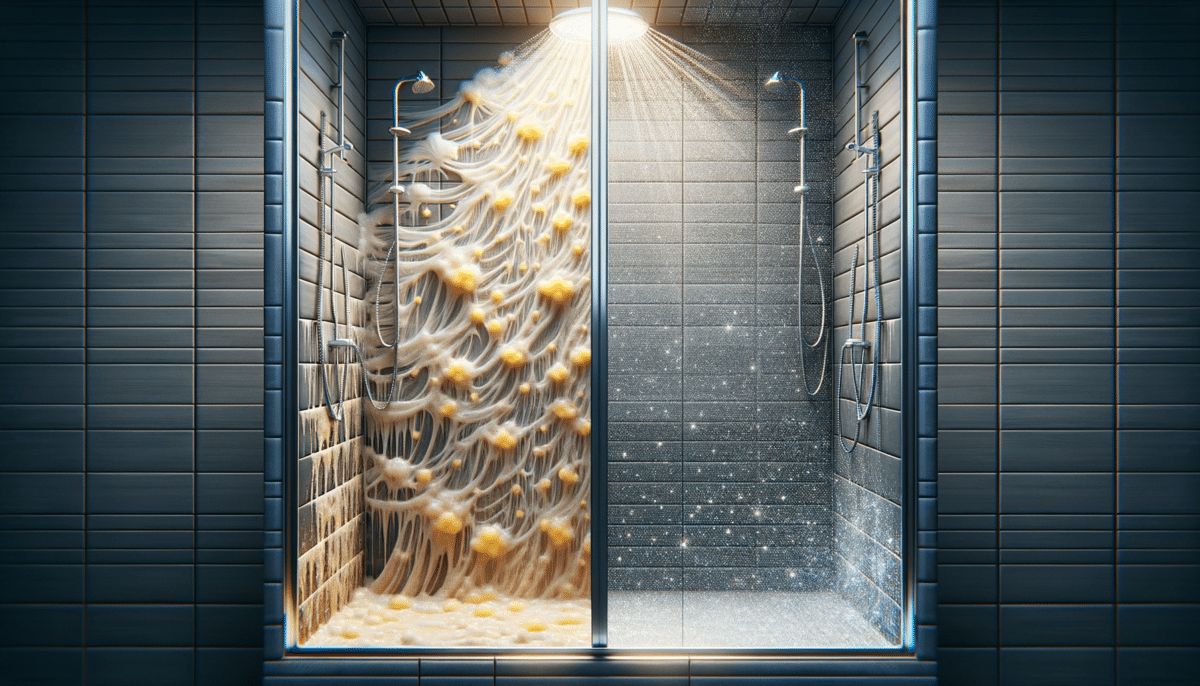Understanding Soap Scum: The Unwanted Guest
Soap scum is a common household nuisance that can make even the most luxurious bathrooms look dingy and unkempt. But what exactly is soap scum? It’s a chalky white or gray film that forms on shower surfaces, tiles, and glass due to the reaction between soap and hard water minerals like calcium and magnesium. This reaction leaves behind a stubborn residue that can be difficult to remove, making it a persistent problem for many homeowners.
Soap scum buildup is not just an aesthetic issue. Over time, it can lead to more serious problems, such as mold and mildew growth. Mold thrives in moist environments, and soap scum provides the perfect breeding ground. This can lead to health issues, especially for individuals with allergies or respiratory problems. Therefore, tackling soap scum not only keeps your bathroom looking pristine but also contributes to a healthier living environment.
To effectively manage soap scum, it’s essential to understand its composition and the factors that contribute to its formation. Hard water is the primary culprit, as it contains high levels of dissolved minerals. When soap is used in hard water, it doesn’t dissolve completely, leading to the formation of soap scum. Additionally, the type of soap used can impact the severity of the buildup, with bar soaps often contributing more to the problem than liquid soaps.
Prevention: The First Step to a Scum-Free Shower
Preventing soap scum buildup is often easier than dealing with it after it has formed. One of the simplest ways to prevent soap scum is by using a squeegee to wipe down shower surfaces after each use. This practice removes excess water and soap residue, reducing the chances of scum formation.
Another effective prevention strategy is to install a water softener. By reducing the mineral content in your water, a water softener can significantly decrease the amount of soap scum that forms. This is particularly beneficial in areas with hard water, where soap scum can be a persistent problem.
Choosing the right cleaning products can also make a big difference. Opt for liquid soaps instead of bar soaps, as they tend to leave less residue. Additionally, using a daily shower spray can help keep surfaces clean and free of soap scum. These sprays are designed to prevent buildup by breaking down soap and mineral deposits before they can adhere to surfaces.
- Use a squeegee after every shower
- Install a water softener
- Choose liquid soaps
- Use a daily shower spray
Cleaning Techniques: How to Remove Stubborn Soap Scum
When it comes to removing soap scum, having the right tools and techniques is crucial. Start by gathering the necessary supplies: a good scrub brush, a non-abrasive sponge, and a quality cleaning solution specifically designed for soap scum removal.
One effective cleaning method involves using a mixture of vinegar and baking soda. Vinegar is a natural acid that can break down mineral deposits, while baking soda acts as a gentle abrasive. To use this method, sprinkle baking soda on the affected areas, then spray with vinegar. Allow the mixture to sit for a few minutes before scrubbing with a brush or sponge. Rinse thoroughly with water and dry the surfaces with a clean towel.
For more stubborn stains, consider using a commercial cleaner formulated for soap scum. These products often contain stronger acids or detergents that can cut through tough buildup. Follow the manufacturer’s instructions carefully to ensure safe and effective use.
Natural Alternatives: Eco-Friendly Solutions for Soap Scum
If you prefer to avoid harsh chemicals, there are several natural alternatives that can effectively tackle soap scum. Lemon juice, for example, is a natural acid that can dissolve mineral deposits. Simply apply lemon juice to the affected areas and let it sit for a few minutes before scrubbing and rinsing.
Another natural option is using a mixture of hydrogen peroxide and baking soda. This combination creates a powerful cleaning paste that can lift soap scum without the need for commercial products. Apply the paste to the areas with soap scum, let it sit for a few minutes, then scrub and rinse.
These eco-friendly solutions not only help maintain a clean shower but also reduce your environmental impact by minimizing the use of chemical cleaners. They are safe for both your health and the planet, making them a great option for environmentally conscious homeowners.
- Lemon juice as a natural acid
- Hydrogen peroxide and baking soda paste
- Eco-friendly and safe for the environment
Maintaining a Clean Shower: Tips for Long-Term Success
Once you’ve removed the soap scum, maintaining a clean shower requires consistent effort. Regular cleaning is key to preventing buildup and keeping your bathroom looking its best. Consider setting a cleaning schedule that includes weekly deep cleans and daily maintenance tasks.
Incorporate daily habits such as wiping down surfaces with a microfiber cloth or squeegee after each use. This simple step can prevent water spots and soap residue from accumulating. Additionally, keeping your bathroom well-ventilated can help reduce moisture levels, which in turn minimizes mold and mildew growth.
By adopting these practices, you can enjoy a sparkling clean shower that remains free of soap scum. Not only will this enhance the appearance of your bathroom, but it will also contribute to a healthier living space for you and your family.
- Set a regular cleaning schedule
- Use a microfiber cloth or squeegee daily
- Ensure proper bathroom ventilation
